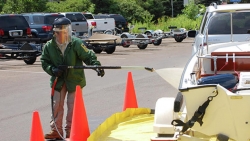Boat Manufacturers Work to Minimize the Spread of Aquatic Invasive Species
Aquatic Invasive Species (AIS) harm water access, fishing, boating and tourism. A technical information report has been published for boat manufacturers to reference that provides information regarding Aquatic Invasive Species (AIS) with consideration to the design and construction of boats, trailers, engines, components, and accessories in order to minimize the spread of AIS.

Annapolis, MD, August 15, 2018 --(PR.com)-- The American Boat & Yacht Council (ABYC), the nonprofit organization that develops voluntary safety standards for recreational boats, has published a technical information report that provides information regarding Aquatic Invasive Species (AIS) with consideration to the design and construction of boats, trailers, engines, components, and accessories in order to minimize the spread of AIS. The report reviews current AIS inspection and decontamination processes and provides best practices and recommendations for manufacturers to reference.
“Developing the AIS technical report was a great collaborative effort between the boating industry and the natural resource management community,” said Brian Goodwin ABYC technical director. “The result is a tool to aid boat builders and the rest of the industry in creating products that not only help reduce the spread of AIS but also improve the overall boating experience.”
AIS include plant life such as Eurasian watermilfoil and water hyacinth, and animals such as spiny water flea, quagga and zebra mussels. These species damage ecosystems and negatively impact fishing by depleting natural food resources, altering the water environment, and changing the structure of the ecosystem.
The impact of AIS has already resulted in the limiting of boat access to many aquatic resources throughout North America, the closure of public boat ramps, and the reduction of availability for fishing and boating across the United States. A large number of federal, state, and local agencies have enacted laws and regulations for inspections, permits, launch availability, and water access for vessels entering public waterways.
AIS infestation can also often result in serious damage to boats and their components. Invasive plant life can foul propellers, jam impellors and cause bilge pump failure. Mussels can attach to boats and negatively affect performance, attach to engines causing component failure, and obstruct water lines causing system failure.
The technical information report is a result of the work originally initiated at ABYC’s AIS Summit in January 2015, which brought together boating industry leaders and the natural resource management community to engage in an in-depth dialogue about how to build a better boat that will drain better, is easier to clean and dry, and is easier to inspect and decontaminate.
An upcoming ABYC AIS Summit will be held Sept. 20, 2018, in Annapolis to build on the collaborative work to date.
Download the AIS technical information report for free here: www.abycinc.org/AISreport
“Developing the AIS technical report was a great collaborative effort between the boating industry and the natural resource management community,” said Brian Goodwin ABYC technical director. “The result is a tool to aid boat builders and the rest of the industry in creating products that not only help reduce the spread of AIS but also improve the overall boating experience.”
AIS include plant life such as Eurasian watermilfoil and water hyacinth, and animals such as spiny water flea, quagga and zebra mussels. These species damage ecosystems and negatively impact fishing by depleting natural food resources, altering the water environment, and changing the structure of the ecosystem.
The impact of AIS has already resulted in the limiting of boat access to many aquatic resources throughout North America, the closure of public boat ramps, and the reduction of availability for fishing and boating across the United States. A large number of federal, state, and local agencies have enacted laws and regulations for inspections, permits, launch availability, and water access for vessels entering public waterways.
AIS infestation can also often result in serious damage to boats and their components. Invasive plant life can foul propellers, jam impellors and cause bilge pump failure. Mussels can attach to boats and negatively affect performance, attach to engines causing component failure, and obstruct water lines causing system failure.
The technical information report is a result of the work originally initiated at ABYC’s AIS Summit in January 2015, which brought together boating industry leaders and the natural resource management community to engage in an in-depth dialogue about how to build a better boat that will drain better, is easier to clean and dry, and is easier to inspect and decontaminate.
An upcoming ABYC AIS Summit will be held Sept. 20, 2018, in Annapolis to build on the collaborative work to date.
Download the AIS technical information report for free here: www.abycinc.org/AISreport
Contact
ABYC
Shannon Aronson
410-990-4460 x105
www.abycinc.org
Shannon Aronson
410-990-4460 x105
www.abycinc.org
Multimedia
Categories

